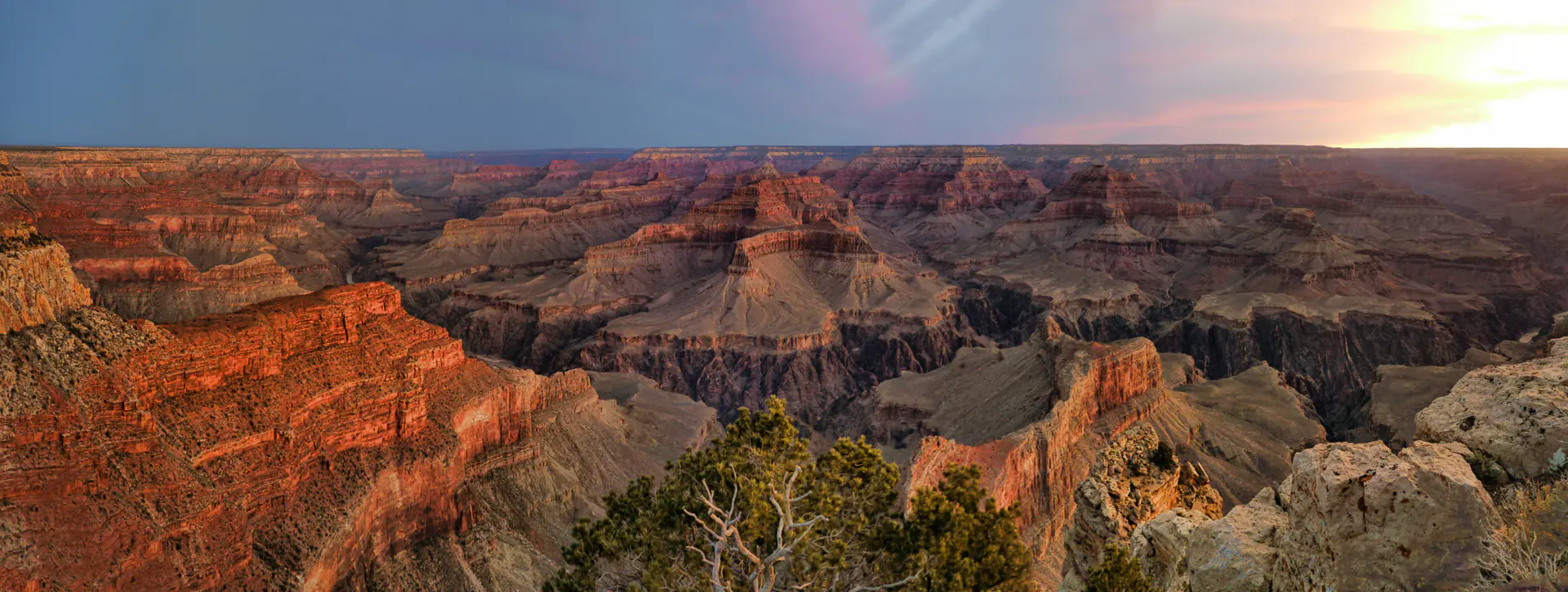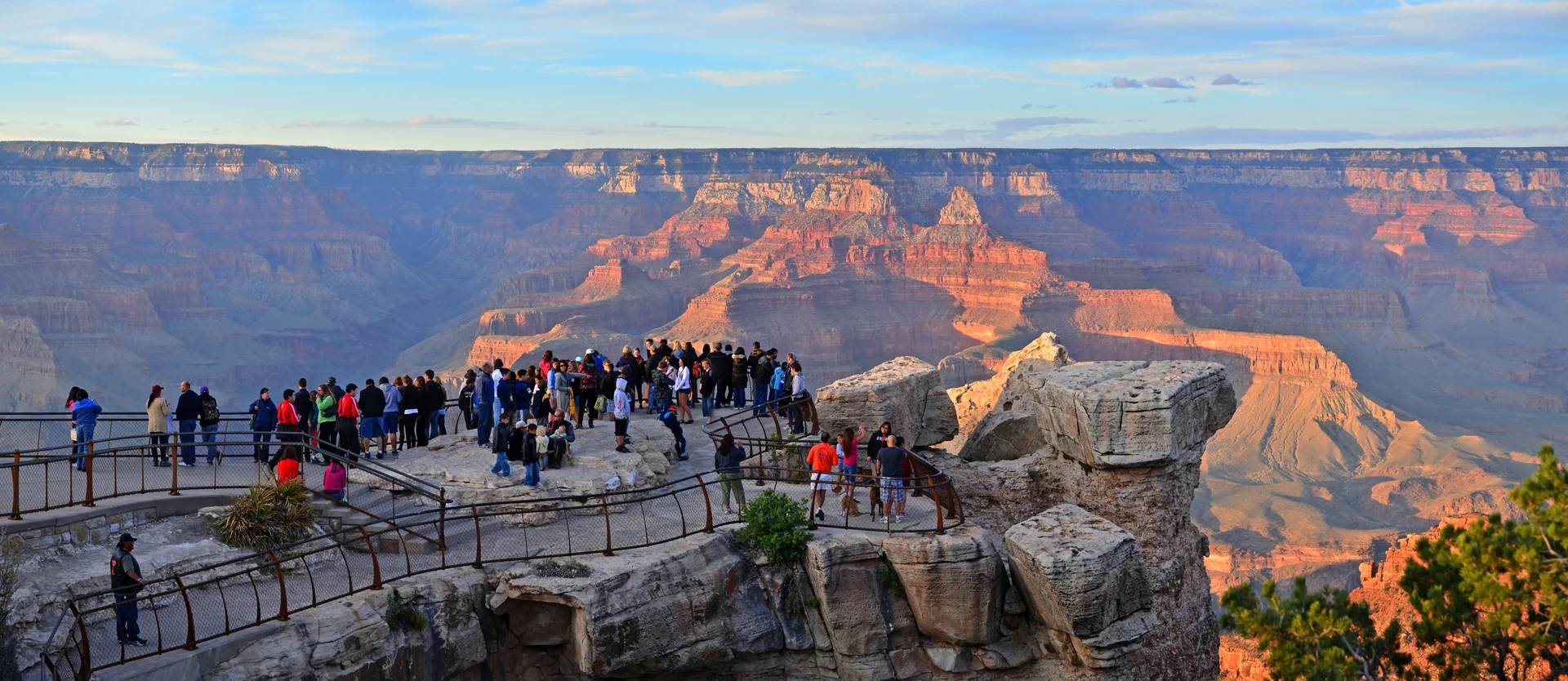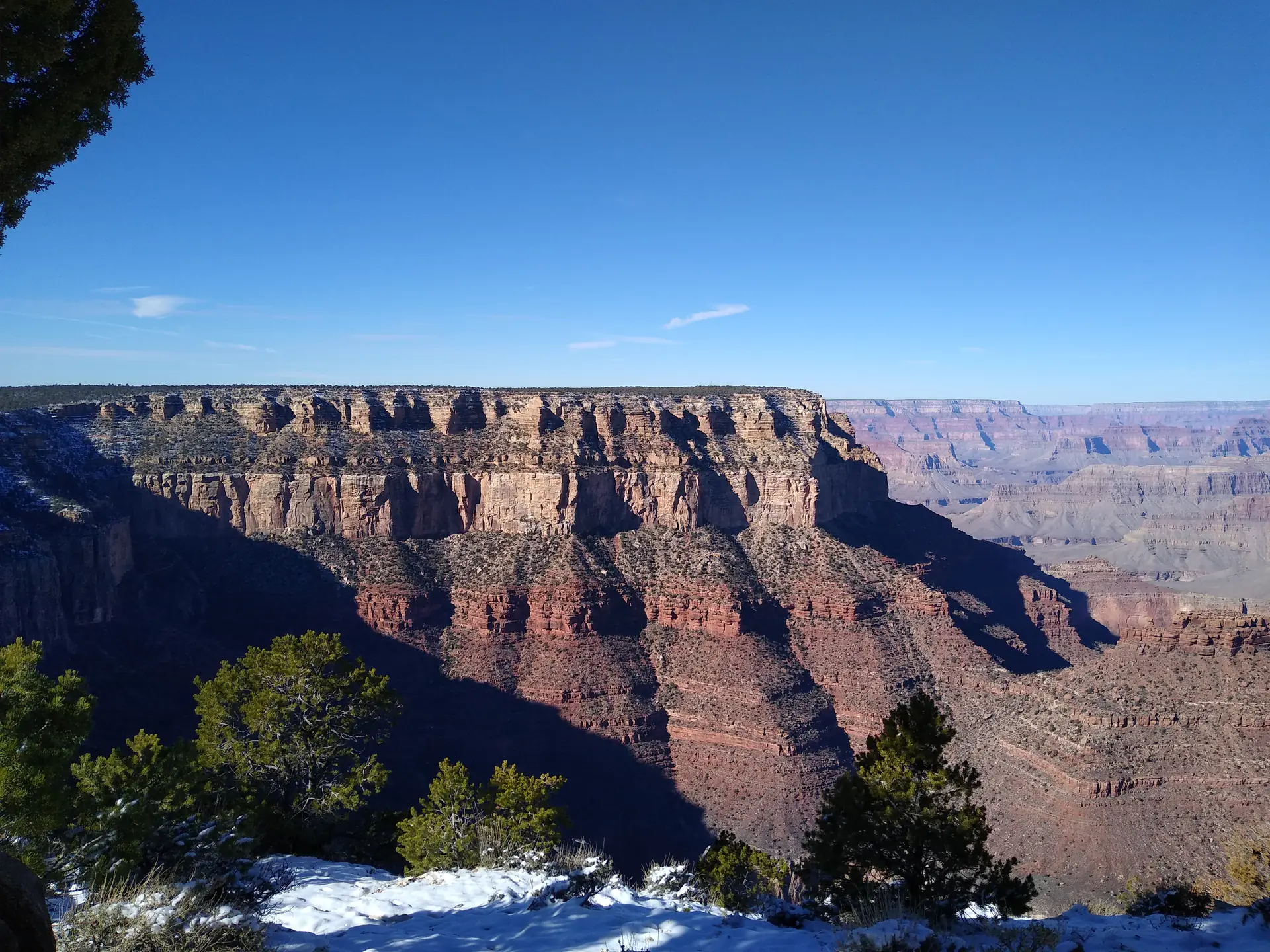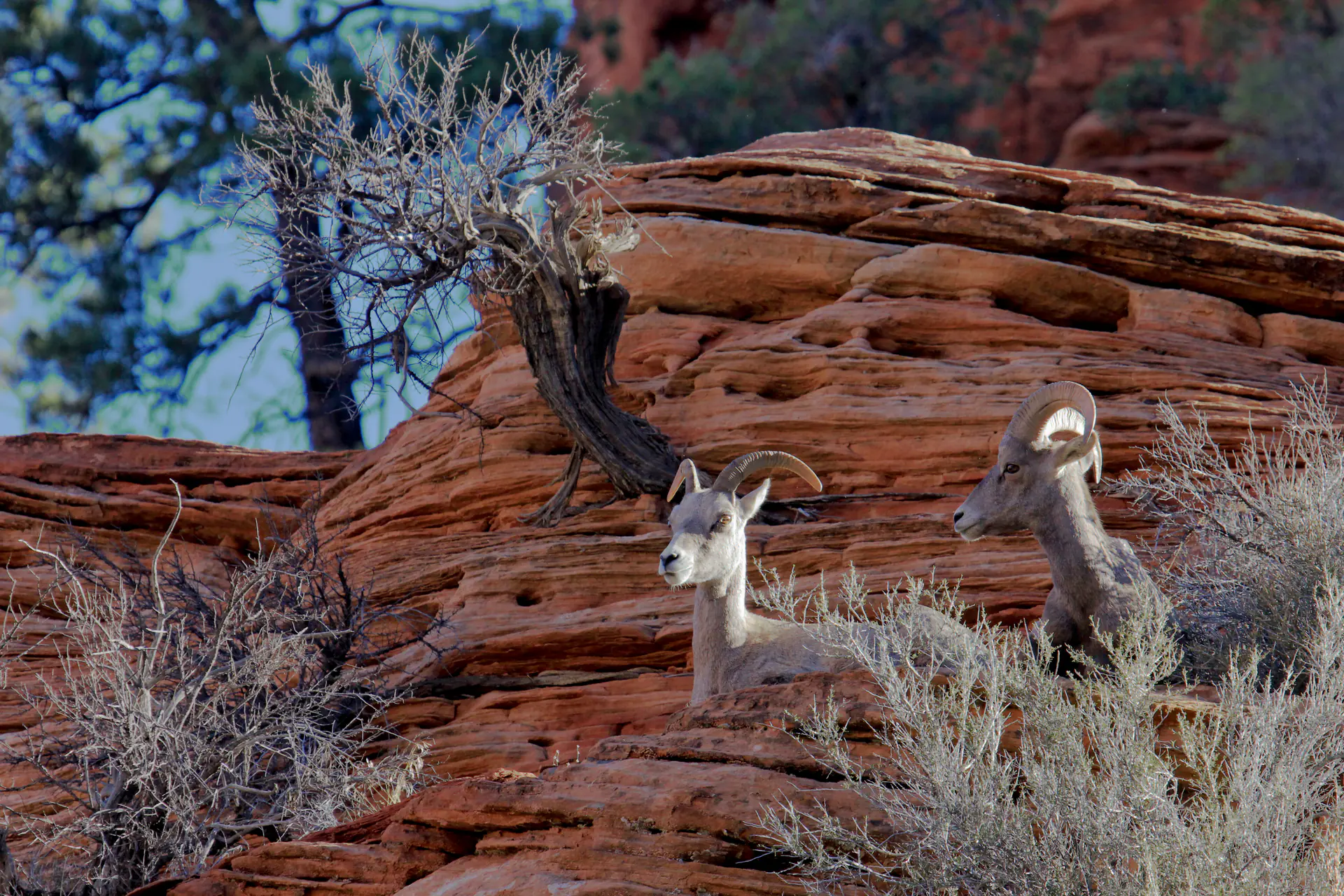
Grand Canyon's Two Billion Years of Layered Geology
Witness Earth's Magnificent Gorge Carved by the Colorado River
About This Site
Grand Canyon National Park showcases Earth's most spectacular geological cross-section, where the Colorado River carved through 2 billion years of rock layers over 5-6 million years. This dramatic chasm reaches nearly 1,857 metres deep and extends 446 kilometres long across the Colorado Plateau. This UNESCO World Heritage site represents the pinnacle of erosional landscape beauty with layered rock formations revealing ancient seas, mountains, and deserts whilst supporting diverse ecosystems from desert scrub to alpine forests. The canyon offers unparalleled opportunities to witness ongoing geological processes, extraordinary biodiversity, and indigenous cultural heritage across dramatic elevation changes throughout the American Southwest, attracting millions annually.
Why It Matters
Grand Canyon demonstrates superlative natural phenomena and outstanding geological processes spanning nearly half of Earth's history through incomparable erosional landscapes. Its layered rock formations reveal exceptional evidence of biological evolution, whilst supporting diverse ecosystems with rare and endemic species across extraordinary elevation gradients throughout five distinct life zones.
Geological Wonders and Natural Phenomena

South Rim Panoramic Viewpoints
The South Rim delivers the most accessible Grand Canyon perspectives, with Mather Point serving as the iconic first encounter where the canyon's immense scale becomes immediately apparent. This viewpoint showcases classic vistas with Paleozoic rock formations creating distinct colour bands from cream Kaibab limestone through red Supai formations to dark Vishnu basement rocks. The accessible 13-kilometre Rim Trail connects multiple viewpoints including Yavapai Point with its geology museum, Hopi Point offering spectacular sunsets, and Hermits Rest at the western terminus. These perspectives demonstrate how the Colorado River carved through sedimentary layers whilst tributaries created complex temples, buttes, and amphitheatres defining this extraordinary sculptural landscape.

Ancient Geological Rock Layers
The Grand Canyon exposes Earth's most complete geological record, with 40 distinct rock layers revealing 2 billion years of planetary history through exceptionally preserved sedimentary sequences. The Great Unconformity represents a 1.2 billion year gap where Precambrian Vishnu schist contacts Cambrian Tapeats Sandstone, documenting massive erosional episodes. Overlying Paleozoic formations including Bright Angel Shale, Redwall Limestone, and Coconino Sandstone preserve ancient marine environments, desert dunes, and coastal plains through distinctive fossils. Each layer reveals changing climates, advancing seas, and evolving life forms from Precambrian stromatolites through Paleozoic marine invertebrates. This spectacular cross-section allows visitors to walk through geological time whilst witnessing ongoing erosional processes exposing deeper formations.

Colorado River Journey Experience
The Colorado River carved the Grand Canyon through persistent erosion over 5-6 million years, transporting massive sediment loads whilst continuing to deepen the chasm at measurable rates. Multi-day rafting expeditions provide intimate perspectives on ongoing geological processes, accessing remote side canyons and ancient indigenous sites whilst navigating powerful rapids created by tributary debris flows. Lava Falls represents one of North America's most challenging whitewater rapids, whilst calmer sections reveal towering canyon walls rising from river level. River trips descend through climate zones from cool rim forests to scorching inner canyon temperatures exceeding 43°C (109°F), experiencing all major geological formations from perspectives impossible to achieve from rim viewpoints.

North Rim Wilderness Solitude
The North Rim offers dramatically different perspectives at higher elevations (2,438 metres versus 2,134 metres) with lush ponderosa pine and aspen forests creating a wilderness atmosphere that receives only 10% of visitors. North Rim viewpoints including Bright Angel Point and Cape Royal provide spectacular vistas across the canyon whilst looking down into side canyon systems like Roaring Springs Canyon. The cooler climate supports different communities including Kaibab squirrels found nowhere else, representing isolated evolution following canyon formation that separated rim populations. Challenging hiking trails descend into remote sections like the North Kaibab Trail, offering solitude and pristine experiences unavailable at the busier South Rim whilst demonstrating how elevation creates dramatically different ecosystems.

Desert Bighorn Sheep and Wildlife Diversity
Grand Canyon supports extraordinary biodiversity across five distinct life zones from Lower Sonoran desert scrub through Upper Sonoran pinyon-juniper woodlands, Transition zone ponderosa forests, Canadian zone mixed conifers, to Hudsonian spruce-fir forests at highest elevations. Desert bighorn sheep navigate steep canyon walls with remarkable agility, representing successful conservation efforts whilst California condors soar on thermal updrafts demonstrating endangered species recovery from near extinction. The park protects 91 mammal species including mountain lions, elk, and mule deer alongside 447 bird species, 56 reptile and amphibian species, and 1,750 plant species. This exceptional biodiversity reflects dramatic elevation gradients creating compressed life zones equivalent to driving from Mexico to Canada whilst research documents climate change impacts on species distributions.
Location & Planning
Grand Canyon Village provides lodging, restaurants, and visitor centre. Book accommodation well in advance for peak seasons. Free shuttle system connects South Rim viewpoints. Multi-day rafting trips need 12-18 months advance booking through commercial outfitters.
Loading map...
Frequently Asked Questions
Grand Canyon is a massive gorge carved by the Colorado River over 5-6 million years, exposing 2 billion years of geological history through spectacular layered rock formations. Famous for its immense scale at 446 kilometres long and 1,857 metres deep.
The Colorado River carved Grand Canyon over 5-6 million years through persistent erosion, cutting through uplifted Colorado Plateau rock layers whilst transporting massive sediment loads. Downcutting continues today, though Glen Canyon Dam now regulates flow patterns affecting natural processes.
March through May and September through November offer moderate temperatures and fewer crowds with ideal hiking conditions. South Rim remains accessible year-round, whilst North Rim operates mid-May through mid-October only. Summer brings extreme inner canyon heat.
Day hiking to the Colorado River and back is extremely dangerous and strongly discouraged by park rangers due to extreme elevation changes and temperature variations. Most rim-to-river hikes require overnight camping with advance backcountry permits.
The oldest exposed rocks at the canyon bottom are Vishnu schist and Zoroaster granite dating nearly 2 billion years ago, formed during Earth's Precambrian era. These represent metamorphosed ocean floor sediments with overlying layers documenting subsequent geological periods.
South Rim at 2,134 metres elevation remains open year-round with extensive facilities serving 90% of visitors, whilst North Rim at 2,438 metres operates seasonally offering wilderness solitude and lush forests. North Rim provides different canyon perspectives with fewer crowds.
Pack ample water, sun protection including hat and sunscreen, sturdy hiking boots, and layered clothing for temperature changes. Bring energy snacks, camera, and binoculars. Below-rim hikers need extra water, electrolytes, first-aid supplies, and emergency communication devices.
UNESCO World Heritage Criteria
Inscribed in 1979, this site meets 4 of UNESCO's 10 criteria for Outstanding Universal Value
Criterion (vii): Contains superlative natural phenomena
The Grand Canyon contains superlative natural phenomena through its overwhelming scale reaching 1,857 metres deep and 29 kilometres wide, spectacular multi-coloured rock layers creating one of Earth's most visually stunning landscapes, and the mighty Colorado River carving through ancient geology in displays of raw natural power.
Criterion (viii): Outstanding geological processes
The canyon represents an outstanding example of Earth's geological history, exposing nearly two billion years of rock layers from Precambrian basement through Palaeozoic sediments, documenting tectonic uplift, marine transgressions, and erosional processes that reveal fundamental insights into our planet's evolution and formation.
Criterion (ix): Outstanding ecological/biological processes
The site demonstrates outstanding ecological processes through five distinct life zones spanning from Sonoran Desert lowlands to boreal forests on the North Rim, showcasing elevation-driven biodiversity across 1,500 metres of vertical relief and adaptive strategies organisms employ across dramatically varied environmental gradients.
Criterion (x): Contains threatened species
Grand Canyon provides essential habitat for threatened species including California condor recovery populations, endangered humpback chub endemic to Colorado River, and over 1,750 plant species, whilst its isolated micro-environments support unique evolutionary adaptations and serve as critical refugia for desert-adapted wildlife.
Historical Context
Indigenous Peoples Heritage (12,000+ years)
Archaeological evidence documents continuous human presence for at least 12,000 years, with ancestral Puebloan peoples inhabiting canyon areas before 1300 CE. Modern Havasupai, Hualapai, Navajo, Hopi, Paiute, and Zuni nations maintain deep spiritual and cultural connections through sacred sites and ongoing traditions.
Spanish and American Exploration (1540-1869)
Spanish conquistadors under García López de Cárdenas became the first Europeans to view the canyon in 1540. Major John Wesley Powell led the first documented river expedition through the canyon in 1869, creating detailed geological observations and maps that sparked scientific interest.
Tourism Development Era (1870-1919)
Railroad arrival in 1901 transformed Grand Canyon into a major tourist destination with development of hotels, viewpoints, and infrastructure. Fred Harvey Company and architect Mary Colter created culturally-influenced structures including Desert View Watchtower integrating indigenous architectural motifs.
National Park Protection (1919-1979)
Grand Canyon National Park establishment in 1919 provided federal protection, with expanded boundaries protecting entire watershed ecosystem. Civilian Conservation Corps developed visitor infrastructure during the 1930s including trails, buildings, and rim facilities still used today.
UNESCO World Heritage Designation (1979)
UNESCO World Heritage inscription in 1979 recognised the canyon's outstanding universal value for geological processes, superlative natural phenomena, and biological diversity across extraordinary elevation gradients. International recognition strengthened protection against external threats including proposed dams and development projects whilst enhancing global awareness.
Modern Conservation Challenges (1979-present)
Contemporary management balances substantial visitation (exceeding 6 million annually in peak years 2017-2019, approximately 4.7 million in 2023) with ecosystem protection, addressing uranium mining threats, invasive species control, California condor recovery, and climate change adaptation whilst maintaining indigenous peoples' cultural connections and access rights.
Conservation & Protection
Current Conservation Status
Protected as a U.S. National Park with comprehensive UNESCO World Heritage oversight, implementing ecosystem-based management strategies balancing preservation of geological processes and biological diversity with sustainable visitor access and indigenous cultural rights.
Conservation Challenges
- Climate change impacts including altered precipitation patterns, increasing temperatures, and drought stress affecting water availability and ecosystem distributions
- Air pollution from regional sources reducing visibility and depositing atmospheric nitrogen affecting delicate desert plant communities
- Uranium mining proposals on adjacent lands threatening groundwater contamination of springs and seeps supporting unique endemic species
- Substantial visitor pressure (4-6 million annually) requiring careful crowd management protecting fragile rim and below-rim environments
- Glen Canyon Dam operations disrupting natural sediment transport and river flows affecting riparian ecosystems and beaches
- Invasive species including tamarisk and cheatgrass altering natural fire regimes and competing with native vegetation
- Aircraft noise from commercial air tours impacting wilderness character and wildlife behaviour throughout canyon airspace
Active Conservation Efforts
- Comprehensive endangered species recovery programmes successfully restoring California condor populations through captive breeding and release whilst monitoring desert bighorn sheep populations across canyon habitats
- Invasive species control programmes targeting tamarisk removal and cheatgrass management protecting native plant communities through mechanical and biological control methods
- Colorado River ecosystem restoration through managed flow experiments coordinating with Glen Canyon Dam operations attempting to restore natural sediment transport and beach building processes
- Air quality monitoring programmes tracking pollution sources and implementing regional partnerships reducing visibility-impairing emissions protecting pristine viewsheds
- Sustainable tourism initiatives including shuttle systems, timed entry considerations, and Leave No Trace education programmes reducing environmental impacts from millions of annual visitors
- Tribal consultation and co-management programmes respecting indigenous peoples' cultural connections whilst incorporating traditional ecological knowledge into contemporary conservation strategies
- Extensive geological and ecological research partnerships with universities and research institutions advancing understanding of climate change impacts, erosional processes, and ecosystem adaptations
Image & Content Attribution
Research & Content Sources
Photography & Visual Media
Last updated: 10 October 2025